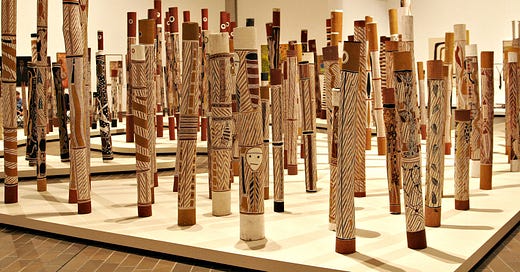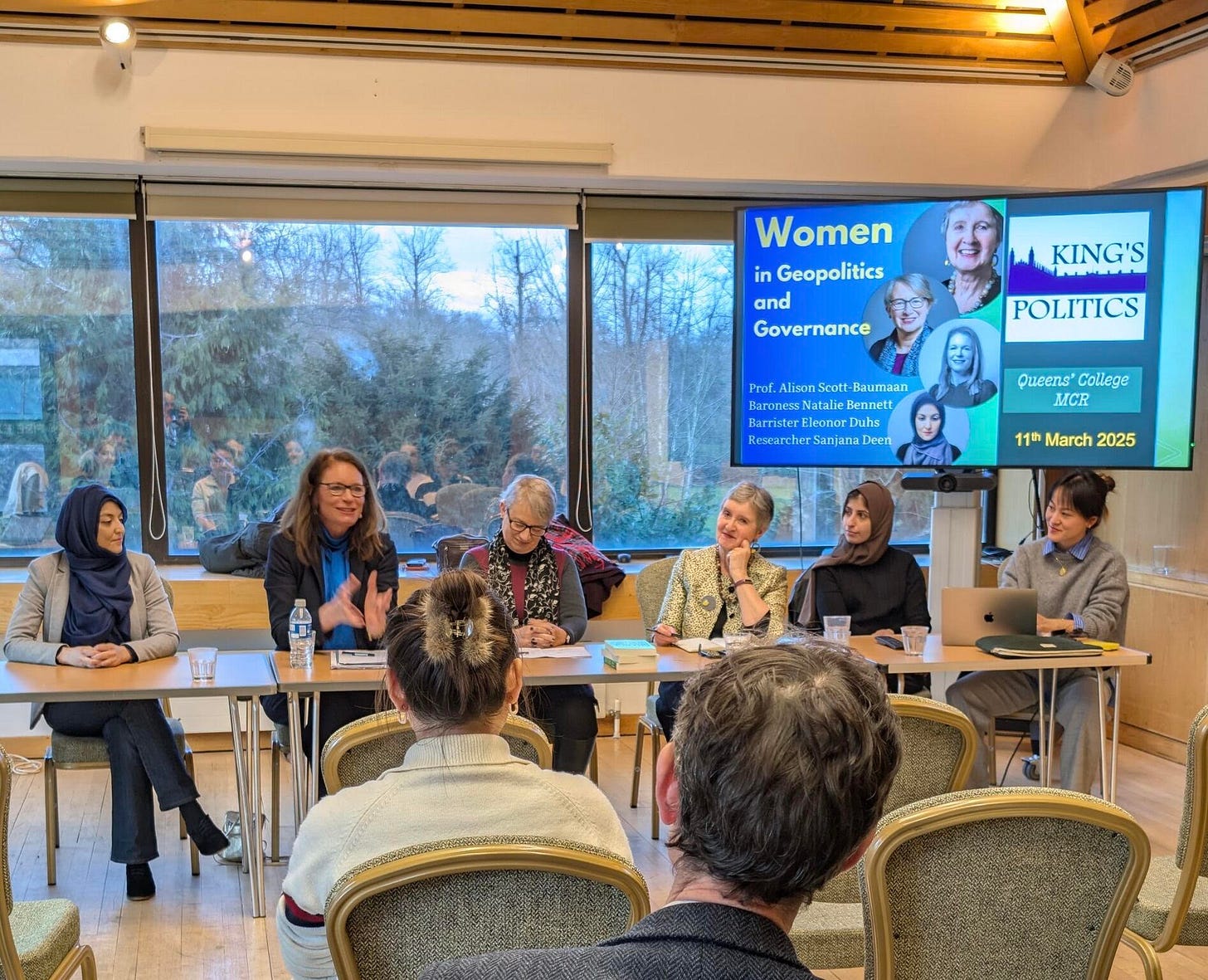Change Everything No 39: Colonial barbarity: different continents, the same story
Remembering Jandamarra and Mangi Meli, resistance leaders in Australia and Africa
Book news
I enjoyed a long and fascinating discussion - blending topics in Change Everything and my forthcoming book with Routledge about escaping from 20th-century thinking - on the Sentientism podcast. Hope you enjoy it too.
I’ll also be talking Change Everything next weekend at the Scotonomics conference in Dundee. Looking forward to it - hope to see you there if that’s in your patch!
Since I was just asked about it, I looked up a US indie source for Change Everything: $7.99 for the e-book.
Also should mention that I enjoyed a great session at Cambridge last weekend with the Queen’s and King’s College political societies and ICOP from SOAS. And was delighted in chatting to the porters to find they were interested: left them a copy too!
Picks of the week
Reading
We are hearing lots of debate about trade at the moment - and I’m usually alone in the House of Lords questioning the damage it does. I’ve been reading a book setting out a few of the disasters that it has created, The World That Trade Created: Society, Culture, and the World Economy, 1400 to the Present.
“India still had large elephant herds of its own. But it turns out that they were the wrong sort of elephants. First, elephants were used in warfare in India, so princes had to protect some of them. Second, the demand for ivory was mainly ornamental. The world’s largest land animals were destroyed so that people could make jewelry. In the case of Gujarat, the demand was high for ivory marriage bangles and rings. Marriageable women apparently sought shiny white jewelry to dangle from their arms and fingers. Unfortunately for Mozambique’s herds, that meant that prospective brides preferred the bright tusks of African elephants to the yellower ones of native Indian pachyderms. A transoceanic trade was mobilized by fashion preferences of Indian girls and mothers, which led to the slaughter of an estimated 30,000 elephants in Mozambique alone in the 80 years after 1750. The magnificent and intelligent mammoths and their great transporting power were reduced to the value of their tusks—their meat was only rarely consumed. Indeed, the world’s largest land mammal was ignored in the trade—only the commodity of ivory, measured in pounds not lives, was sold.” (p. 47, 2017, 4th edition)
And this edition also has a fascinating tale of today:
Erik Prince—founder of the private security firm Blackwater, which became notorious during the Iraq war and ran into various legal problems in the United States—later founded a new security firm based in Abu Dhabi, ready to defend that regime from anything from terrorism to unrest among its foreign contract laborers. These mercenaries were, of course, themselves foreign contract laborers, though of an elite sort: most of the rank and file are from Colombia (often veterans of the drug wars there) while others are South African; the trainers are mostly American and European veterans of special forces units. (Part of the plan appeared to be to avoid hiring Muslims, for fear that they might be reluctant to fire on other Muslims.) Prince later sold that firm, and founded a new company, based in Hong Kong, that scouts investments and provides security services in various parts of Africa, and is rumored to work with Chinese intelligence on some of these projects. He and his family, who are staunch supporters of privatizing schools, also strongly supported the Presidential campaign of Donald Trump; Prince apparently represented Trump at a meeting in the Seychelles with Russian friends of Vladimir Putin, while his sister, Betsy DeVos, became Trump’s Secretary of Education. (p. 310)
Listening
I love learning about subjects of which I previously knew nothing, and the Common Descent podcast on Temnospondyls delivered that pleasure. They were mostly amphibious tetrapods from the very dawn of terrestrial life right through to after the end-Permian mass extinction. Some were croc-like monsters up to 6 metres long, but many were like our amphibions of today, modest little creatures of pond and lake. And they underwent metamorphosis- an extraordinarily complex process - from very early on, although like some of today’s amphibians, they sometimes arrested the process if conditions allowed. They might (clearly a source of much debate) be the ancestors of our amphibians today. (Source)
Thinking
No, it is not intelligent, and not, crucially, accurate. An interesting study of so-called AI finds it is much worse than standard search engines in finding the source of information. Worse, it frequently “hallucinates”, as proponents like to say, otherwise known as simply makes up sources. They were “confidently wrong”, and the premium models were even worse than the free. Did anyone say “wildly overhyped technology”?
Researching
We knew it, but good to demonstrate it: playing with dogs is good for humans (and dogs.) Since my lifestyle doesn’t allow for a dog at the moment, thank you for everyone who has allowed me to play with theirs! One of my aims in life is to one day have a small pack of wildly mismatched rescue dogs…. one day.
Photo by Matt Nelson on Unsplash
Seeking respect for the dead
I’ve put the longer read down the bottom of this week’s newsletter, because it comes with a trigger warning - very disturbing accounts of execution and abuse of human remains are to be found below.
Source: The Aboriginal Memorial, National Gallery of Australia
I generally keep my more “academic” and political work separate, but last Thursday they combined, in a debate in the Moses Room, our second chamber, called by Labour’s Lord Boateng:
To ask His Majesty’s Government what assessment they have made of the offence caused to the indigenous peoples affected by the sale of human body parts in public auctions, and their display and retention in public collections.
You can read the complete (short) debate here, and well worth it is. Crossbencher Baroness Black of Strome, a forensic anthropologist, spoke about the general lack of law on human remains. (Warning, her speech is definitely not for the faint-hearted.)
As I said in the debate, I come from a white settler background in Australia, and I grew up on unceded lands that were stolen from the Aboriginal people (the Wallumedegal). I told two tales of colonial barbarity, beginning with one from the genocide with which white settlers established themselves on the Australian continent.
On the land of the Bunuba people in what is now Western Australia, Jandamarra became a famous leader of the indigenous resistance. For three years, he was hunted by settlers and police, until in 1897, when he was aged about 24, he was cornered by the police, shot and killed, and his body was beheaded. His skull was sent as a colonial trophy to a private museum in a gun factory in Birmingham. The factory was demolished in the 1960s and Jandamarra’s skull has disappeared.
Bunuba elders and researchers continue to this day to search for that skull. His story is very important to indigenous people and other people in Australia. It was first put on stage as a play at the 2008 Perth International Arts Festival and, more recently, it was staged with the Bunuba people by the Sydney Symphony Orchestra.
The second story comes from another continent, with another European coloniser, but starts with a modern-day campaigner, Mnyaka Sururu Mboro. Speaking for his ancestors, in Berlin, last year, he opened a symposium on colonial human remains with these words:
“Free us from the museums. Free us from the basements where they spray us now and then with disinfectant. Free us from the universities, from the clinics where they keep us on the shelves with the skulls of monkeys, gorillas and orangutans. Free us from the depots where we cannot breathe. Bring us back home and rest us in peace forever”.
At the conference where those words were said, he also told a story told to him by his grandmother about an acacia tree where she, with hundreds of others, was forced in 1900 to witness the hangings of 19 regional leaders, among them Mangi Meli. He was regarded as the most senior, so he was the last to die. After he was hanged, the Germans chopped off Mangi Meli’s head and took it for their colonial collections. There is no record of it after that.
Two different colonised nations, two different awful colonial powers, two remarkably similar stories.
Rightly, the APPG for Afrikan Reparations also points to the issue of Egyptian mummies. We might have thought that we had made some progress since the days when mummies were ground up for medicines or even to colour paint. There was a colour of paint called Mummy Brown, made from the flesh of mummies mixed with white pitch and myrrh, from the mid-18th century into the 20th century.
It is worth noting that last year the Chau Chak Wing Museum at the University of Sydney decided to remove fragments of mummies from public display, and has been seeking to rename its so-called mummy room to something more respectful. They removed a mummified foot that had been donated in an old biscuit tin, the preserved feet and partial shins of a child, a partially bandaged adult head and a mummified hand that had been donated in a separate biscuit tin. As the curator there said, the ancient Egyptians are not around as a people today to object to this disrespectful treatment, but that does not mean that we should not look more broadly than just at those remains for whom there are identifiable peoples who are still able to speak for them.
This is a geopolitical issue and an issue of reparations. Most foundationally of all, it is an issue about what kind of society we want to be. It is not about the remains at all; it is about us and what we are like. If we are going to be respectful of human life of the past, the present and the future; what is in our museums; what our children visit and view; what our scholars study; and how they are presented with the past, that has an impact on the nature of our society today.
Almost the end
Seeking a reference: I remember reading a tale of the attempt to export British woollen products to India. A use was eventually found for these scratchy, uncomfortable garments – protecting cannon from rain. But can't now find the source. Any help much appreciated!
What did you think?
You can also find me on Instagram, Facebook, LinkedIn, TikTok and X.








Thanks Natalie - it was such a pleasure to talk to you for @Sentientism!
https://youtu.be/dG_YD4Uj9hk